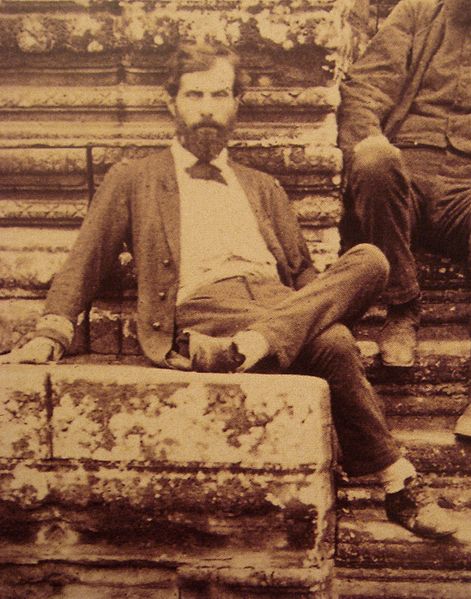<Back to Index>
- Explorer Marie Joseph François Garnier, 1839
- Painter Thomas Cowperthwait Eakins, 1844
- Prime Minister of the United Kingdom Arthur James Balfour, 1848

Marie Joseph François (Francis) Garnier (25 July 1839 - 21 December 1873) was a French officer and explorer known for his exploration of the Mekong River in Southeast Asia.
He was born on July 25, 1839 at Saint-Étienne, Loire, and entered the French Navy, and after voyaging in Brazilian waters and the Pacific, he obtained a post on the staff of Admiral Léonard Victor Charner, who from February 1860 to November 1861 was campaigning in Cochinchina. After some time spent in France, Garnier returned to the East, and in 1862, he was appointed inspector of the natives in Cochinchina, and entrusted with the administration of Cholon, a suburb of Saigon.
It was at his suggestion that the marquis de Chasseloup-Laubat determined to send a mission to explore the valley of the Mekong River, but as Garnier was not considered old enough to be put in command, the chief authority was entrusted to Captain Ernest Doudard de Lagrée. In the course of the expedition - to quote the words of Sir Roderick Murchison addressed to the youthful traveller when, in 1870, he was presented with the Victoria Medal of the Royal Geographical Society of London - "from Kratie in Cambodia to Shanghai 5392 miles were traversed, and of these, 3625 miles, chiefly of country unknown to European geography, were surveyed with care, and the positions fixed by astronomical observations, nearly the whole of the observations being taken by Garnier himself". Volunteering to lead a detachment to Dali, the capital of Sultan Suleiman, the sovereign of the Muslim rebels in Yunnan, Garnier successfully carried out the more-than-adventurous enterprise. When shortly afterwards Lagrée died, Garnier naturally assumed the command of the expedition, and he conducted it in safety to the Yangtze River, and thus to the Chinese coast. On his return to France, he was received with enthusiasm. The preparation of his narrative was interrupted by the Franco-Prussian War, and during the siege of Paris, Garnier served as principal staff officer to the admiral in command of the eighth sector. His experiences during the siege were published anonymously in the feuilleton of Le Temps, and appeared separately as Le Siège de Paris, journal d'un officier de marine (1871).
Returning
to Cochinchina, he found the political circumstances of the country
unfavourable to further exploration, so accordingly, he went to China,
and in 1873 followed the upper course of the Yangtze River to the waterfalls. Garnier met his death in controversial circumstances. In late 1873 he was sent by Admiral Dupré, the governor of Cochinchina, to Tonkin,
to resolve a dispute between the Vietnamese authorities and the French
entrepreneur Jean Dupuis. Persuaded that the time was ripe for a French
conquest of Tonkin, Garnier captured Hanoi,
the capital of Tonkin, 20 November 1873. In the next few weeks a small
French force under Garnier's command captured most of the citadels of
the Red River Delta. The Vietnamese authorities, despairing of meeting
the French with their own forces, appealed to the notorious Chinese
soldier of fortune Liu Yongfu to come to their aid with his Black Flag Army. On 21 December 1873 Liu Yongfu and around 600 Black Flags (French: pavillons noirs, drapeaux noirs),
marching beneath an enormous black banner, approached the west gate of
Hanoi. A large Vietnamese army followed in their wake. Garnier began
shelling the Black Flags with a field piece mounted above the gate, and
when they began to fall back led a party of 18 French marine
infantrymen out of the city to chase them away. The attack failed.
Garnier, leading three men uphill in a bayonet attack on a party of
Black Flags, was stabbed and hacked to death by several Black Flag
soldiers after stumbling in a watercourse. The youthful enseigne de vaisseau Adrien-Paul
Balny d’ Avricourt led an equally small column out of the citadel to
support Garnier, but was also killed at the head of his men. Three
French soldiers were also killed in these sorties, and the others fled
back to the citadel after their officers fell. Garnier's
death effectively ended the first French adventure in Tonkin. The
French government disavowed Garnier's adventure and hastened to
conclude a peace settlement with the Vietnamese, abandoning most of its
claims in Tonkin.
Garnier's
chief fame rests on the fact that he originated the idea of exploring
the Mekong, and carried out the larger portion of the work. During the
French colonial period he was also honoured for his feats of arms in
Tonkin, which paved the way for the eventual French conquest of Tonkin
in the 1880s. In 1883, nine years after Francis Garnier's death, the French naval officer Henri Rivière was also killed by the Black Flags in Tonkin, in remarkably similar circumstances. Garnier
and Rivière were honoured during the French colonial period as
the two pre-eminent French martyrs of the conquest of Tonkin. In 1884,
during the Sino-French War, two gunboats of the Tonkin Flotilla were named after the two men. During the siege of Tuyen Quang (November
1884–March 1885), Liu Yung-fu's Black Flags, who formed part of the
besieging Chinese army, taunted the men of the French garrison by
chanting the names of their two most famous victims: 'Garnier!
Rivière! Garnier! Rivière!' In 1943, French Indochina issued a postage stamp commemorating Garnier.